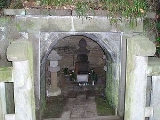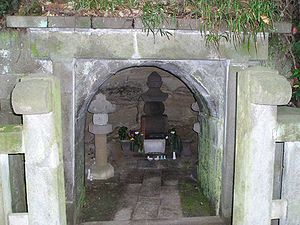
Oe no Hiromoto
Encyclopedia

Ōe no Hiromoto (1148–1225) was a kuge
Kuge
The was a Japanese aristocratic class that dominated the Japanese imperial court in Kyoto until the rise of the Shogunate in the 12th century at which point it was eclipsed by the daimyo...
(court noble) and vassal of Japan
Japan
Japan is an island nation in East Asia. Located in the Pacific Ocean, it lies to the east of the Sea of Japan, China, North Korea, South Korea and Russia, stretching from the Sea of Okhotsk in the north to the East China Sea and Taiwan in the south...
's Kamakura shogunate
Kamakura shogunate
The Kamakura shogunate was a military dictatorship in Japan headed by the shoguns from 1185 to 1333. It was based in Kamakura. The Kamakura period draws its name from the capital of the shogunate...
, and contributed to establishing the shogunate's governmental structure.
A great-grandson of the famous scholar Ōe no Masafusa, he was born to Ōe no Koremitsu and adopted by Nakahara Hirosue but later returned to the Ōe family in 1216. There is another theory that Hiromoto was born to Fujiwara no Mitsuyoshi. As a minor noble, he originally served at the Imperial Court
Imperial Court in Kyoto
thumb|left|350px|Front view of Kyoto imperial palaceImperial Court in Kyoto was the nominal ruling government of Japan from 794 AD until the Meiji Era, in which the court was moved to Tokyo and integrated into the Meiji government....
in Kyoto
Kyoto
is a city in the central part of the island of Honshū, Japan. It has a population close to 1.5 million. Formerly the imperial capital of Japan, it is now the capital of Kyoto Prefecture, as well as a major part of the Osaka-Kobe-Kyoto metropolitan area.-History:...
.
In 1184 he was invited to Kamakura
Kamakura, Kanagawa
is a city located in Kanagawa Prefecture, Japan, about south-south-west of Tokyo. It used to be also called .Although Kamakura proper is today rather small, it is often described in history books as a former de facto capital of Japan as the seat of the Shogunate and of the Regency during the...
by Minamoto no Yoritomo
Minamoto no Yoritomo
was the founder and the first shogun of the Kamakura Shogunate of Japan. He ruled from 1192 until 1199.-Early life and exile :Yoritomo was the third son of Minamoto no Yoshitomo, heir of the Minamoto clan, and his official wife, a daughter of Fujiwara no Suenori, who was a member of the...
, who later founded the Kamakura shogunate. He became the first head (bettō
Betto
is a term which originally indicated the head of an institution serving temporarily as the head of another one, but which came to mean also the full-time head of some institution...
) of the new Kumonjo (Board of Public Documents) in the same year and then of the Mandokoro
Mandokoro
was the chief governing body of an important family or monastic complex in ancient Japan. This name was borrowed for the administrative department of the Shogunate in feudal times....
(Administrative Board) in 1191. On Hiromoto's advice, Yoritomo appointed jitō
Jito
were medieval land stewards in Japan, especially in the Kamakura and Muromachi Shogunates. Appointed by the shogun, jitō managed manors including national holdings governed by the provincial governor ....
and shugo
Shugo
was a title, commonly translated as "Governor," given to certain officials in feudal Japan. They were each appointed by the shogun to oversee one or more of the provinces of Japan...
in 1185, which helped to strengthen shogunal control over the provinces. In 1190 Ōe followed Yoritomo to Kyoto and remained there to negotiate with the imperial court until 1192.
After Yoritomo's death, Ōe won the trust of his widow, Hōjō Masako
Hojo Masako
was the eldest child of Hōjō Tokimasa by his wife Hōjō no Maki, the first shikken, or regent, of the Kamakura shogunate. She was the sister of Hōjō Yoshitoki, and was married to Minamoto no Yoritomo, the first shogun of the Kamakura period...
, and assisted in the Hōjō clan
Hojo clan
See the late Hōjō clan for the Hōjō clan of the Sengoku Period.The in the history of Japan was a family who controlled the hereditary title of shikken of the Kamakura Shogunate. In practice, the family had actual governmental power, many times dictatorial, rather than Kamakura shoguns, or the...
's seizure of power. He was involved in several important events in the shogunate. In 1199 real power was moved from second shogun Minamoto no Yoriie
Minamoto no Yoriie
was the second shogun of Japan's Kamakura shogunate, and the first son of first shogun Yoritomo.- Life :Born from Tokimasa's daughter Hōjō Masako at Hiki Yoshikazu's residence in Kamakura, Yoriie had as wet nurses the wives of powerful men like Hiki himself and Kajiwara Kagetoki, and Hiki's...
to the council of influential gokenin
Gokenin
A was initially a vassal of the shogunate of the Kamakura and the Muromachi periods. In exchange for protection and the right to become shugo or jitō , in times of peace a gokenin had the duty to protect the imperial court and Kamakura, in case of war had to fight with his forces under the...
. In 1203 the shogun was arrested along with his supporter Hiki Yoshikazu
Hiki Yoshikazu
was a Japanese warrior-noble of the Kamakura period related to the ruling Minamoto clan through his daughter's marriage. He, and much of the Hiki clan, were killed for allegedly conspiring to have one of the Minamoto heirs killed, in order to gain power himself....
. Hiromoto also helped the Hōjō clan crush enemies as Hatakeyama Shigetada
Hatakeyama Shigetada
was a samurai who fought in the Genpei War, in Japan. Originally fighting for the Taira clan, he switched sides for the battle of Dan-no-ura, and ended the war on the winning side....
, Hiraga Asamasa and Wada Yoshimori
Wada Yoshimori
was an early Kamakura period military commander. A gokenin of the Kamakura shogunate, he was the first director of the Samurai-dokoro.He was the son of Miura Yoshiaki and grandson of Sugimoto Yoshimune, making him a descendant of the Heike. Among his sons were Wada Yoshinao, Asahina Yoshihide, and...
.
In the Jōkyū War
Jokyu War
', also known as the Jōkyū Disturbance or the Jōkyū Rebellion, was fought in Japan between the forces of Retired Emperor Go-Toba and those of the Hōjō clan, regents of the Kamakura shogunate, whom the retired emperor was trying to overthrow....
he insisted on making a sudden attack to Kyoto and contributed to the shogunate's overwhelming victory. He died after backing up Hōjō Yasutoki
Hojo Yasutoki
Hōjō Yasutoki was the third shikken of the Kamakura shogunate in Japan. He strengthened the political system of the Hōjō regency.He was the eldest son of second shikken Yoshitoki...
's succession. His fourth son founded the Mōri clan
Mori clan
The Mōri clan was a family of daimyō, descended from Ōe no Hiromoto and established themselves in Aki Province. Their name was derived from a shōen in Mōri, Aikō District, Sagami Province. The generation of Hiromoto began to name themselves Mōri.After the Jōkyū War, Mōri was appointed to the jitō...
.

